Adopting a Systematic Approach to Below-grade Waterproofing
by Samantha Ashenhurst | June 12, 2018 9:00 am
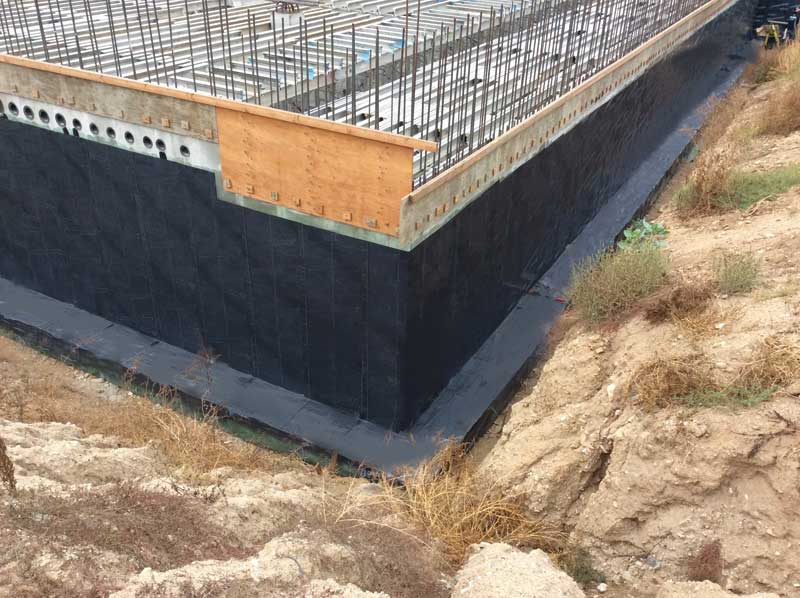 [1]
[1]by Harold Hays
In the waterproofing sector of the commercial construction market, one of the most frequently asked questions is, “What is the best waterproofing product?” Unfortunately, the answer is not so straightforward.
The most accurate answer is, “There is no ‘best’ waterproofing product. The best product is more often a system, and the system depends on the specific project.”
A very important consideration is the geographical location of the project being built. Is it being constructed in Florida, where the water table can routinely be as shallow as 0.61 m (2 ft) below the ground surface? Or is it in Minnesota, where downward traveling water from the spring snowmelt may be the primary concern? Additionally, is it being constructed in an urban area, with existing streets and buildings already adjacent to the site, or is it being built in a suburb where there is ample room to excavate the land to give construction access on all sides of the building foundation?
Another important consideration is the time of installation. Will it be applied in Arizona during July when the daily highs are more than 38 C (100 F) or in North Dakota during November with the highs never expected to go beyond 4 C (40 F)?
Considering just these two basic concerns, it quickly becomes apparent one waterproofing product cannot be “best” for all projects.
This is why it is important to understand waterproofing for a commercial structure must be viewed as a system, and not as a product. Consider these concerns:
- While waterproofing a perfectly flat wall may sound simple enough, how does the contractor address the areas where utilities such as electrical and plumbing pipes enter and exit the building?
- What happens at the bottom of the wall, where the wall meets the footing?
- How is the membrane terminated at the top of the wall to ensure surface water cannot get behind the waterproofing membrane?
- Can waterproofing span cracks or even expansion joints?
- Can the below-grade waterproofing tie into the above-grade air and vapor barrier easily?
Note the location of the foundation (above or below the water table) will dictate if waterproofing or just a vapor barrier is needed below the slab.
 [2]
[2]All of these “additional” conditions necessitate the use of multiple products, which work together to create a waterproof system for the structure.
The most basic example of a waterproofing system would be the use of a contact adhesive or primer being applied to a wall prior to applying of a self-adhered sheet waterproofing membrane. In this scenario, the two products (contact adhesive and membrane) are used in combination to enhance the overall effectiveness of the waterproofing by significantly improving the adhesion between the membrane and the substrate; this ensures the membrane will remain in place prior to and during backfill and if moderate post-construction movement takes place.
In addition to the development of various waterproofing products and accessories, the industry has also gained a greater understanding of why and where structures leak. As such, taking a systematic approach allows the specifier to bring together a combination of products, each with unique properties, strengths, and limitations, in order to address some of the most critical areas of a foundation including:
- wall-to-footing connections;
- penetrations;
- cold-pour joints;
- inside and outside corners;
- membrane terminations;
- expansion joints; and
- tie-in to the below-slab vapor barrier.
The system approach
The following examples illustrate how using a system approach with self-adhered rubberized asphalt sheet membranes for positive-side (i.e. exterior-side) waterproofing ensures a combination of the right products are employed in the right locations, and provides a superior solution to any single product. Finally, as is always the best practice, the waterproofing system is protected by having a drainage composite installed on the outboard side of the membrane.
Detailing non-structural cracks in a concrete substrate
A wall must be properly prepared prior to the installation of any waterproofing membrane. This includes detailing cracks so that the waterproofing membrane has a continuous and acceptable surface to which it can be applied.
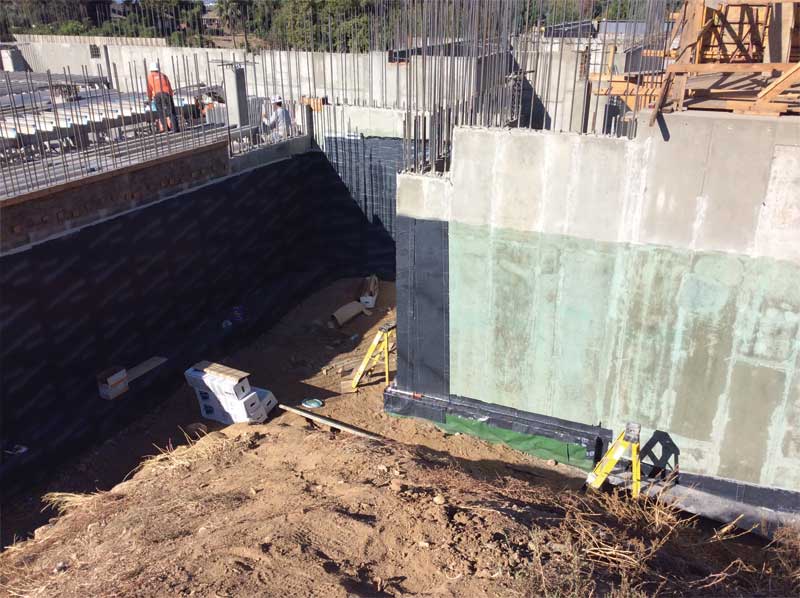 [3]
[3]Cracks in a concrete foundation wall smaller than 1.5 mm (1/16 in.) can simply be detailed with a minimum 229-mm (9-in.) membrane strip, and covered with the field waterproofing membrane (Figure 1). Conversely, cracks 1.5 mm and larger, must be routed out and filled with a flexible one- or two-component, 100-percent solids non-sag polyurethane sealant compatible with the membrane. The sealant must be allowed to cure before installation of the membrane detail strip.
Wall-to-under slab/footing transition to a vapor barrier
An important detail that is often forgotten is the tie-in from below-grade waterproofing to under slab/footing vapor barrier (Figure 2).
A vapor barrier is installed under the slab, and sometimes, the footings, if the building foundation is not located near the water table. The below slab vapor barrier helps to eliminate moisture intrusion through the vapor in the soil. The vapor barrier has to be clean before installation. A 229-mm wide waterproofing membrane detail strip is applied to secure it to the concrete substrate. The membrane extends over the detail strip and terminates on the vapor barrier.
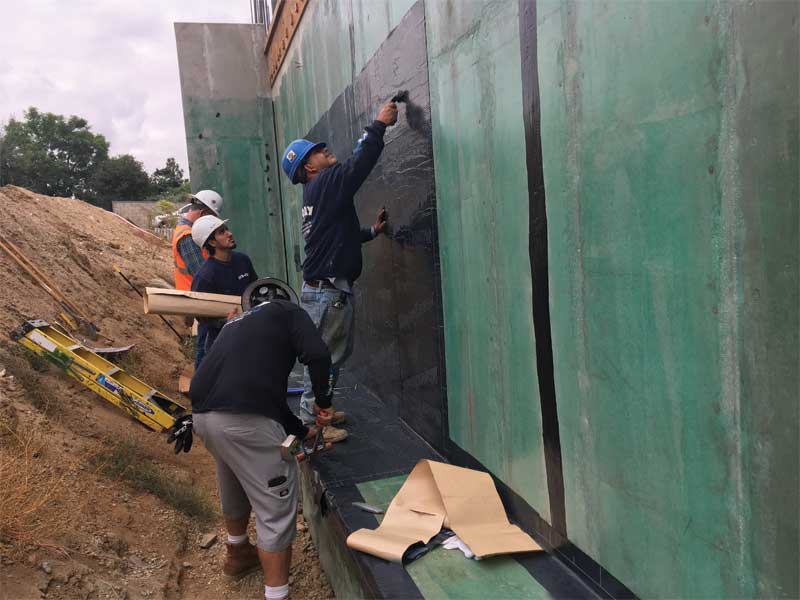 [4]
[4]Wall-to-footing transition and footer termination
A more complex, and probably the most common, condition experienced in below-grade waterproofing involves the junction where the below-grade vertical wall meets the building’s footing (i.e. the horizontal base).
The wall and footing are constructed in separate concrete pours, creating a cold-pour joint. This junction is one of the most critical details in the waterproofing system. As such, prior to the junction being formed, a bentonite-based expanding waterstop is placed where the footing and wall will meet. The waterstop serves as a last line of defense, should the balance of the waterproofing system be damaged post-application or improperly installed.
Following the creation of the wall-to-footing junction, a flexible one- or two-component, 100-percent solids non-sag polyurethane sealant—compatible with the membrane—is placed at the inside corner that is created, creating a minimum 19-mm (¾-in.) face cant bead between the wall and footing.
This cant bead serves two purposes. First, it provides an additional layer of protection to seal the cold joint, inboard of the membrane, so a layer of protection remains if the membrane is accidentally damaged prior to or during backfill. Second, applying any sheet-type product into a 90-degree inside turn can be challenging at best. The potential for “bridging” to occur—where the membrane transitions from the wall to the footing prior to reaching the bottom of the wall—is great. This void or “bridge” is a weak point where a puncture can easily occur during or prior to backfill, and behind which water can laterally migrate. Thus, by creating this polyurethane sealant cant bead, a challenging 90-degree turn is changed into two much more manageable 45-degree turns (i.e. wall to cant bead and then cant bead to footer).
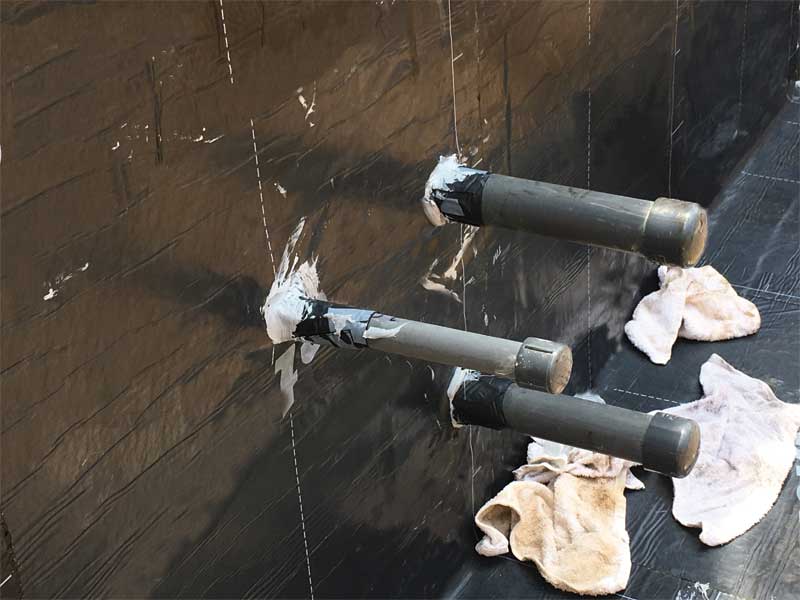 [5]
[5]Following the application of the polyurethane sealant cant bead, a waterproofing membrane detail strip measuring 229-mm wide is applied (Figure 3). This provides a double layer of the self-adhering sheet waterproofing membrane over this critical joint. The self-adhering sheet waterproofing membrane is then installed, extending out onto the footer past the detail strip.
As a final step, self-adhered waterproofing membrane footing terminations must always be addressed to not expose the substrate-to-membrane seam directly to any hydrostatic (e.g. water) head pressures. A rubberized-asphalt mastic or a flexible one- or two-component, 100-percent solids non-sag polyurethane sealant is applied, as a final layer of protection, on top of the field waterproofing membrane along the entire seam where the self-adhered waterproofing membrane terminates on the footing and on all waterproofing membrane seams, extending 305 mm (12 in.) in both directions from the corner.
Pipe penetrations
A pipe penetration through a concrete foundation wall is a bit more challenging for the waterproofing system. Consider that, essentially, a hole is purposely being put in a below-grade wall, but there is still a need to prevent water from entering the structure. By taking the same system approach to this condition, a waterproof result can still be achieved.
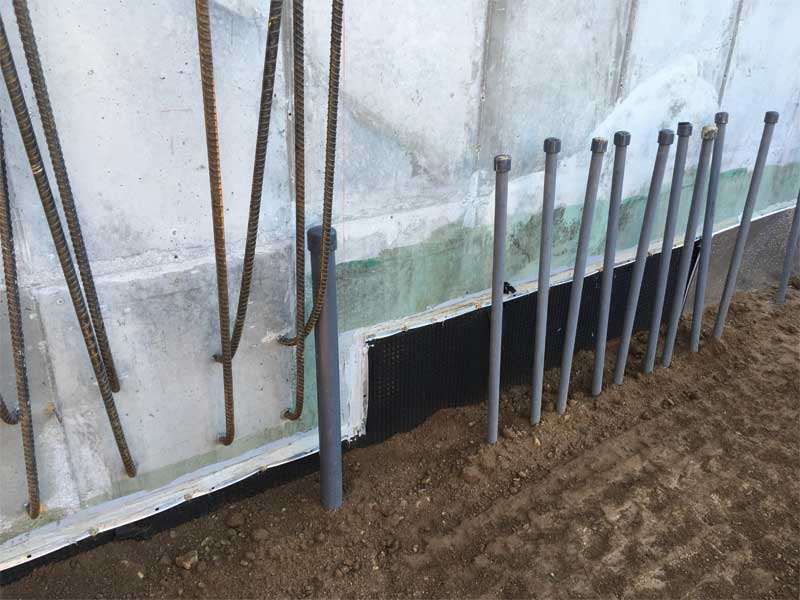 [6]
[6]If the pipe is installed through the concrete forms before the concrete is poured it should be wrapped with an expanding bentonite waterstop (Figure 4).
After the concrete wall is poured and the forms are removed, a polyurethane sealant cant is installed around the pipe, to eliminate the 90-degree turn out onto the pipe. This is similar to the wall-to-footer example described earlier. Then, a 229-mm strip of self-adhered waterproofing membrane, cut halfway through—like a “hula skirt”—is wrapped around the pipe, with the “skirt legs” extending out onto the wall.
The waterproofing membrane flashing is terminated with a pipe clamp and covered with mastic or sealant. Lastly, the field waterproofing membrane is installed and cut tight to the pipe penetration, detailed with mastic or sealant and protected with a drainage composite.
Waterproofing termination at grade
The termination of the self-adhered rubberized-asphalt sheet membrane at grade is very important to the long-term life of the waterproofing system. A rigid metal (aluminum or stainless steel) termination bar is employed (Figure 5).
Since typical waterproofing systems are not ultraviolet (UV) stable and have to be terminated 102 to 152 mm (4 to 6 in.) below grade, a cementitious waterproofing assembly should be employed to protect the area of the wall between the waterproofing termination and grade. The self-adhered rubberized-asphalt waterproofing system is installed up to a determined point and will be permanently secured using a metal termination bar attached at 150 mm
on center (o.c.). Rubberized-asphalt mastic or a polyurethane sealant will be used to cover the termination area. Then the drainage composite will be installed to protect the waterproofing system.
While these examples illustrate just a few of the typical conditions one will encounter on a commercial waterproofing project, they highlight the importance of a “waterproofing system” approach. This approach ensures the best product or accessory is employed on each step and each product is compatible with the one that follows.
Harold Hays is the building envelope systems technical services manager for North America for MAPEI Corporation. He has been in the construction industry for more than 38 years, including 18 years in the architectural field and 17 years in the commercial waterproofing and air and vapor barrier market segments. Hays provides design and installation-related technical service to architects, consultants, building owners, and contractors as well as assists with new product development projects. He can be reached at hhays@mapei.com[7].
- [Image]: https://www.constructionspecifier.com/wp-content/uploads/2018/06/Waterproofing-Anacostia-River-Project2.jpg
- [Image]: https://www.constructionspecifier.com/wp-content/uploads/2018/06/Substrate.jpg
- [Image]: https://www.constructionspecifier.com/wp-content/uploads/2018/06/Waterproof.jpg
- [Image]: https://www.constructionspecifier.com/wp-content/uploads/2018/06/Footing.jpg
- [Image]: https://www.constructionspecifier.com/wp-content/uploads/2018/06/Pipe.jpg
- [Image]: https://www.constructionspecifier.com/wp-content/uploads/2018/06/Steel.jpg
- hhays@mapei.com: mailto:hhays@mapei.com
Source URL: https://www.constructionspecifier.com/adopting-a-systematic-approach-to-below-grade-waterproofing/